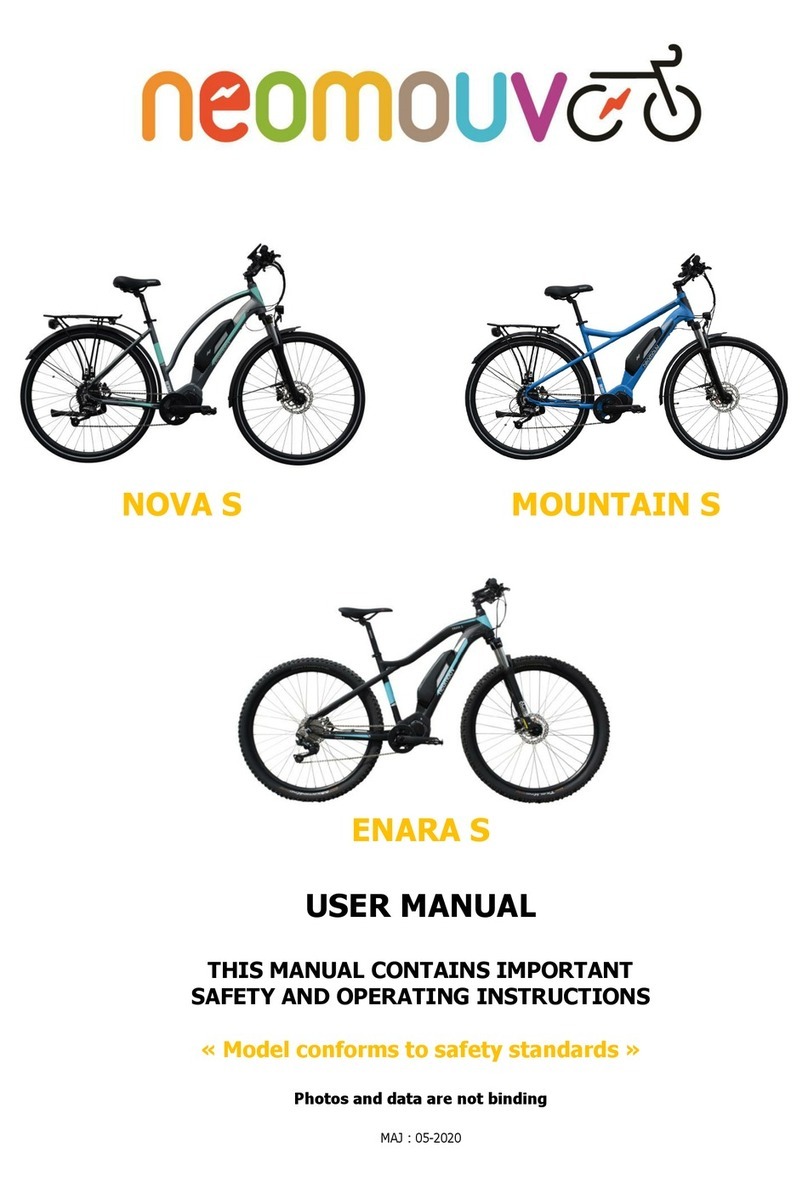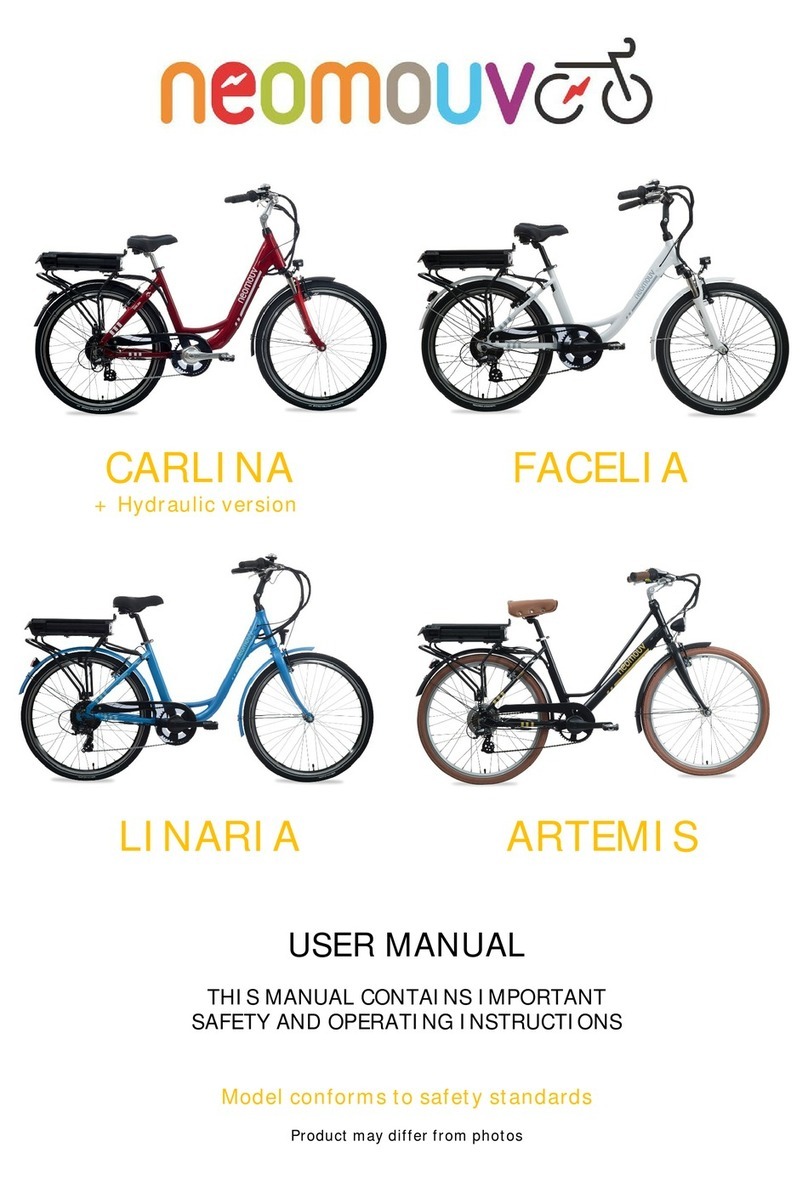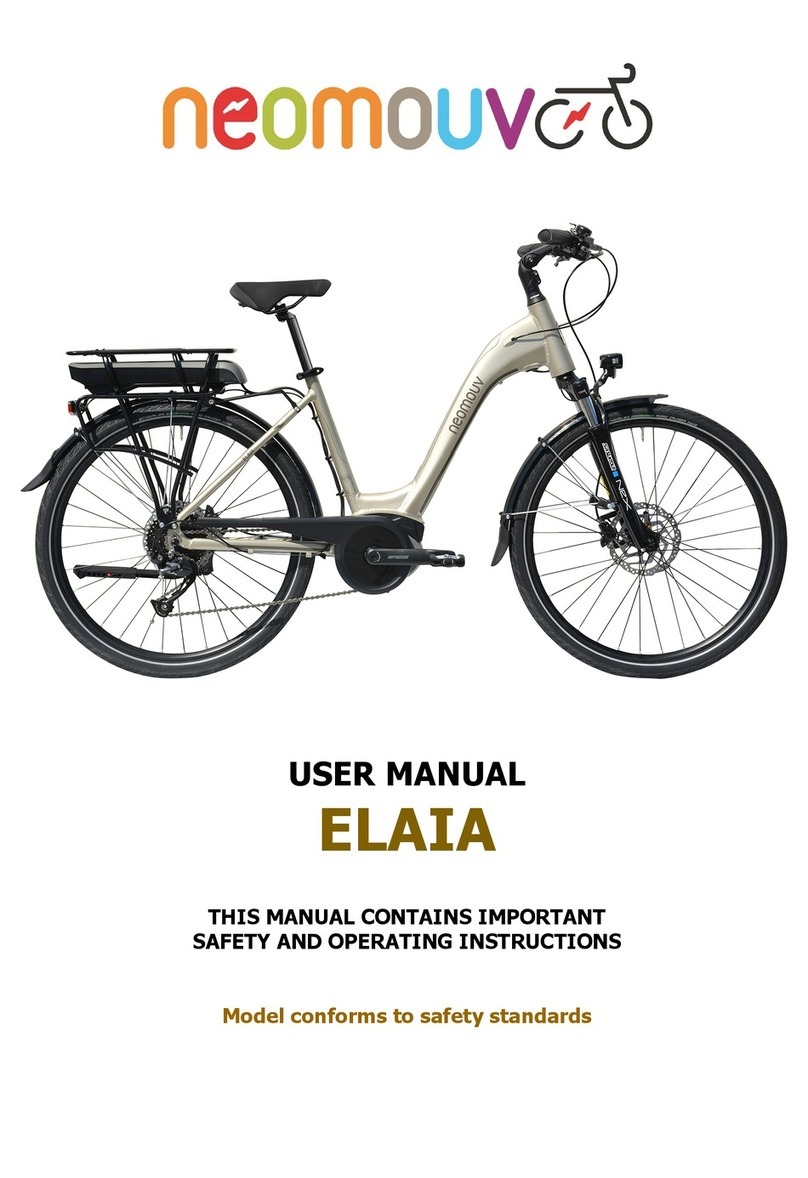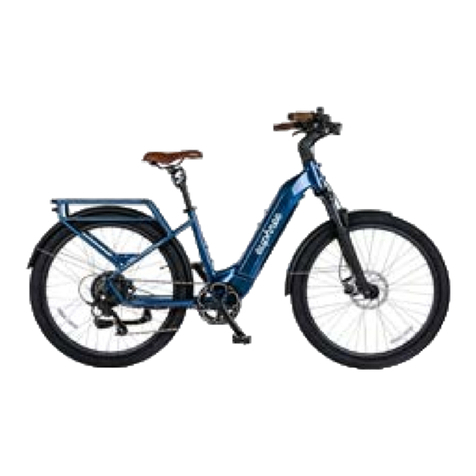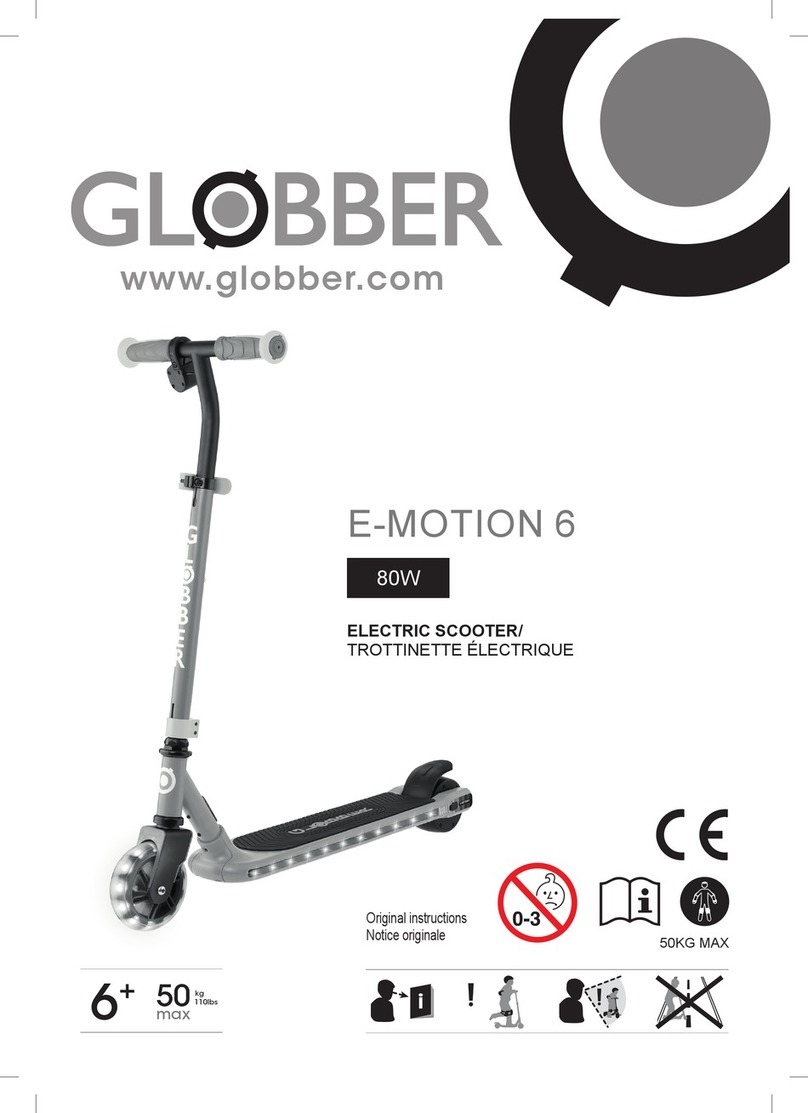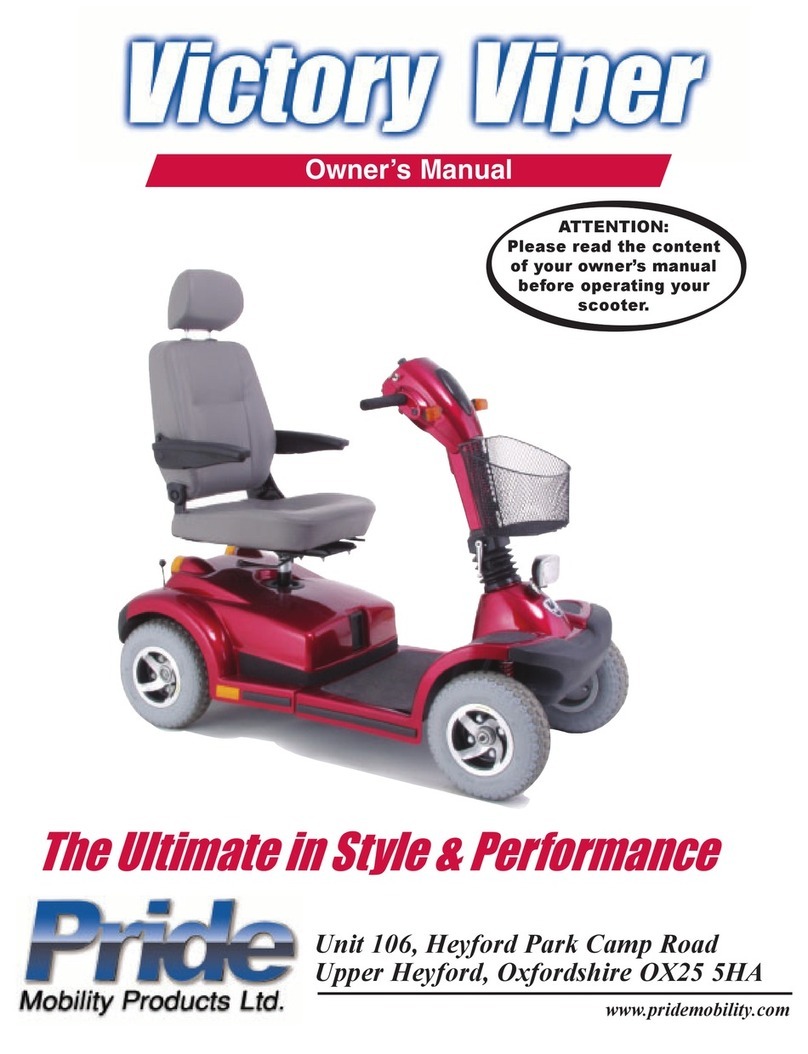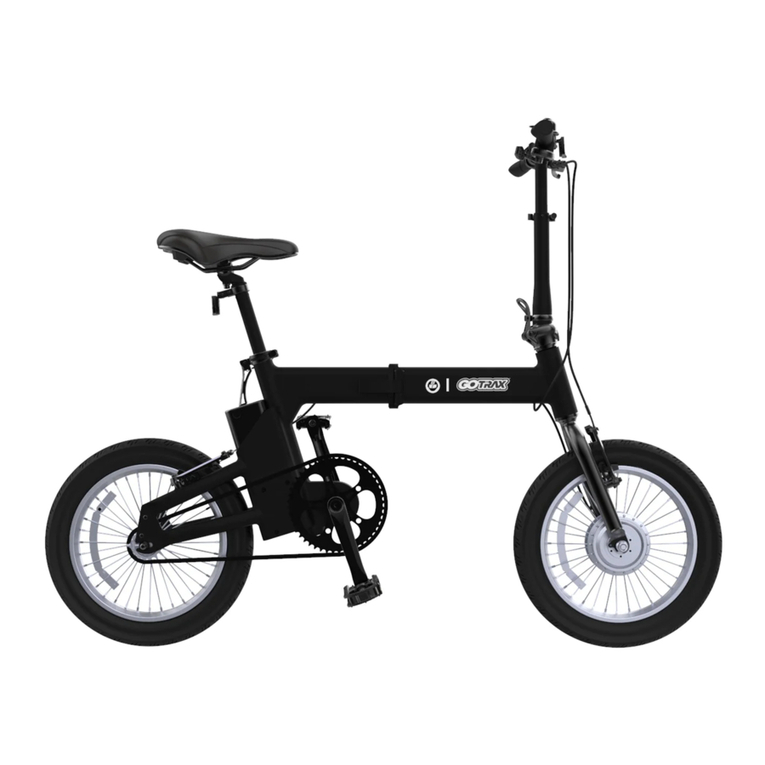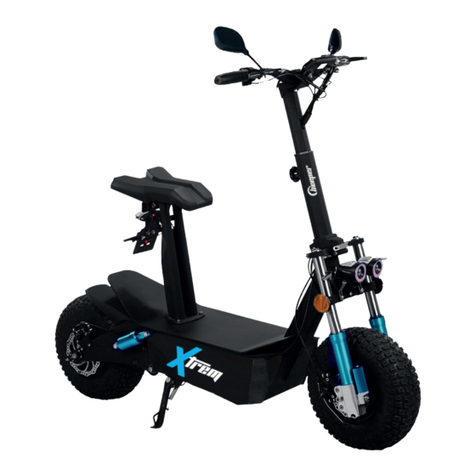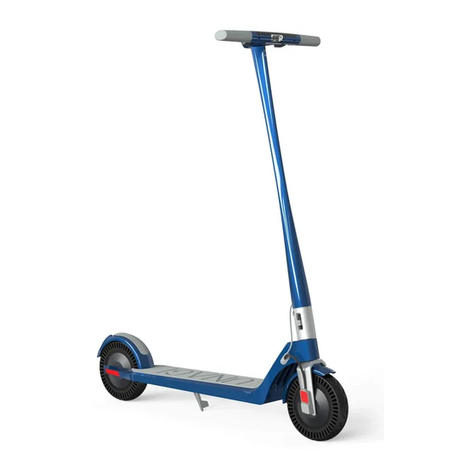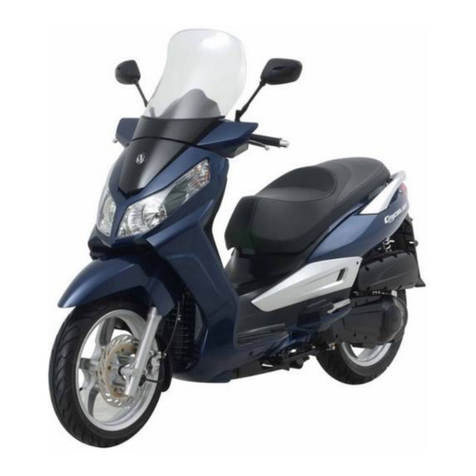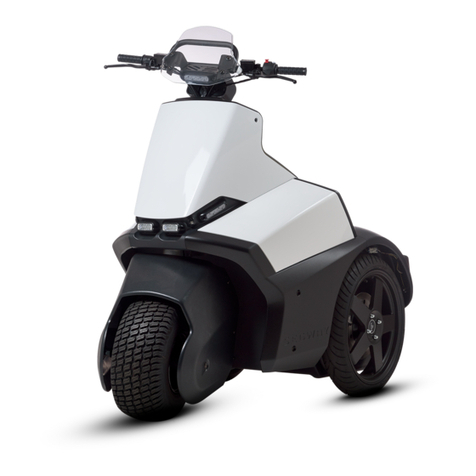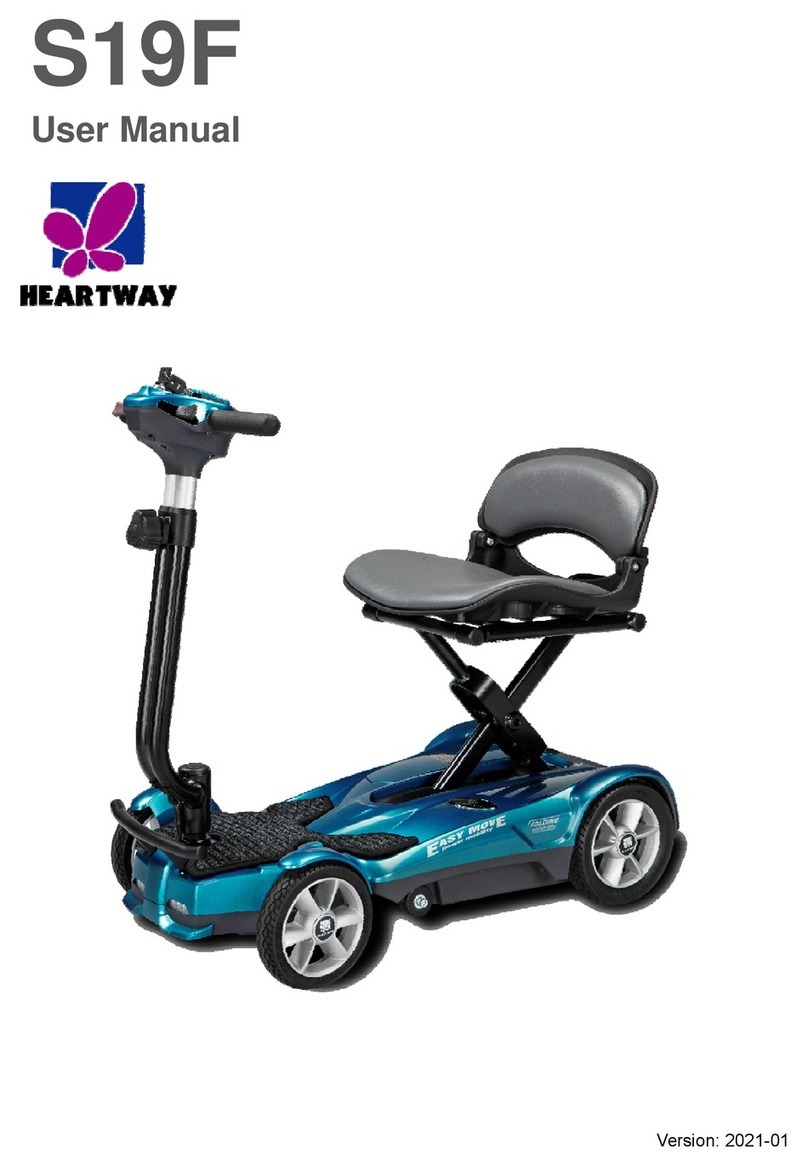neomouv KALYSO User manual

KALYSO +KALYSO HY
KALYSO NUVINCI
USER MANUAL
THIS MANUAL CONTAINS IMPORTANT
SAFETY AND OPERATING INSTRUCTIONS
Model conforms to safety standards
Product may differ from photos

KALYSO –KALYSO HY –KALYSO NV manual
2
CONTENTS
1- Presentation.....................................................................................................................4
2- ADJUSTMENTS/ASSEMBLY: .............................................................................................5
2.1 Saddle adjustment:.................................................................................................................................... 5
2.1.1 Angle:............................................................................................................................................. 5
2.1.2 Height:............................................................................................................................................ 5
2.2 Adjusting the handlebars:.......................................................................................................................... 6
2.3 Adjusting the brakes:................................................................................................................................. 7
2.3.1 Front V-Brake (modèle Kalyso):.................................................................................................... 7
2.3.2 Rear V-Brake (modèle Kalyso):..................................................................................................... 8
2.3.3 Hydraulic brakes (Kalyso Hydraulique and Kalyso Nuvinci models):............................................. 8
2.4 Rack:........................................................................................................................................................ 9
2.5 Mounting and dismounting the wheels................................................................................................... 9
2.5.1 Front wheel (Kalyso and Kalyso Hydraulique model):.................................................................. 9
2.5.2 Rear wheel (Kalyso and Kalyso Hydraulique model):................................................................. 10
2.5.3 Front wheel (Kalyso Nuvinci model):............................................................................................... 11
2.5.4 Rear wheel (Kalyso Nuvinci model):................................................................................................ 11
2.6 Lights:................................................................................................................................................... 11
3 –USING THE E-BIKE: ......................................................................................................12
3.1 Indexed gearshift (Kalyso and Kalyso Hydraulique models): ............................................................. 12
3.2 Gearshift (Kalyso Nuvinci model): ............................................................................................................ 12
3.3 Electronic gear shifting: ........................................................................................................................ 13
3.4 Display and controls:............................................................................................................................ 13
3.5 Electric assistance:................................................................................................................................ 14
3.5.1 Operation:....................................................................................................................................... 14
3.5.2 Performance:................................................................................................................................... 15
3.5.3 Technical specifications of the power-assistance system:............................................................ 15
3.5.4 Starting up the battery: ................................................................................................................. 16
3.5.5 The electric motor: ....................................................................................................................... 16
4 - CHARGING THE BATTERY: ............................................................................................17
4.1 Lithium Ion 36-volt charger ................................................................................................................. 17
4.1.1 Precautions (safety instructions): ..................................................................................................... 18
4.1.2 Protecting the charger:...................................................................................................................... 18
4.2 Battery .................................................................................................................................................. 19
Recommendations / precautions to take with your battery: ......................................................................... 20
5 - TIPS FOR INCREASING THE BATTERY LIFE PER CHARGE:...........................................21
6 - UPKEEP AND MAINTENANCE: .......................................................................................22
6.1 Upkeep:................................................................................................................................................. 22
6.2 Lubrication: .......................................................................................................................................... 22
6.3 Maintenance: ........................................................................................................................................ 22

KALYSO –KALYSO HY –KALYSO NV manual
3
7 - SAFETY –RECOMMENDATIONS:...................................................................................23
8 –TECHNICAL DATA .........................................................................................................24
9 - DECLARATION OF CE CONFORMITY .............................................................................25
10 - CERTIFICATE OF CONFORMITY ..................................................................................25
11 –TERMS OF WARRANTY ...............................................................................................25

KALYSO –KALYSO HY –KALYSO NV manual
4
1- PRESENTATION
Thank you for choosing a NEOMOUV Electric-Assisted Bicycle (E-Bike)
E-Bike Presentation:
Notes:
•The symbol indicates important advice or essential safety measures. Follow the various instructions.
•Some adjustment and assembly/disassembly operations require special tools and expertise; perform
these only if you have the skills to do so, otherwise consult your authorised dealer or a specialist.
•The symbol indicates the tools you will need to carry out adjustments.
•Your e-bike has a serial number engraved on the frame by the fork.
MAXIMUM LOAD:120 KG.FOR YOUR SAFETY,YOU SHOULD NOT EXCEED THE MAXIMUM LOAD WHEN USING
YOUR BICYCLE.
Battery
Electric motor
Torque
sensor
Display
Rack (max load 25 kg)
Controller
Serial number

KALYSO –KALYSO HY –KALYSO NV manual
5
2- ADJUSTMENTS/ASSEMBLY:
2.1 Saddle adjustment:
6 mm Allen Key
2.1.1 Angle:
Loosen the nut under the saddle.
Adjust the angle of the saddle in order to find your most comfortable position. Tighten the nut, with a
maximum tightening torque of 13 Nm.
2.1.2 Height:
The power-assisted bicycle enables you to opt for a lower saddle position than on a classic bike. With power
assistance, you expend less effort and can be seated in a lower position for improved safety. The required
user (cyclist) height for optimal utilisation of the bike ranges from 1.65 to 1.90 m. So, adjust your saddle
height to the correct sitting position as follows:
Loosen the quick release seat clamp.
Wearing suitable cycling shoes, sit on the saddle, place one of the pedals in the lowest position, rest one heel
on the pedal, and your leg should rest normally on the pedal without being stretched. Raise or lower the
saddle to get the correct height. While pedalling backwards, you should not have to move your hips from side
to side.
Loosen the quick release clamp (seat clamp).
THE SEAT POST SHOULD NOT BE EXTENDED BEYOND THE ENGRAVED SAFETY MARK (VERTICAL BARS).
Safety mark
Nut
Seat clamp

KALYSO –KALYSO HY –KALYSO NV manual
6
2.2 Adjusting the handlebars:
6 mm Allen Key
For your comfort, the position of your handlebars must be at the same level as the height of your saddle or a
bit higher according to your comfort. Unscrew the Allen screw and adjust your handlebars to the desired
height.
Do the same with the second screw to set the angle of tour handlebars, after making your adjustments,
tighten the screws vigorously, with a max. tightening torque of 10 Nm.
THE STEM MUST NOT COME OUT OF THE HEAD TUBE BEYOND THE ENGRAVED MARKINGS (VERTICAL BARS AND
THE INSCRIPTION MINIMUM INSERTION).
After adjusting the angle, tighten the screw by turning it clockwise (max. tightening torque: 10 Nm).
Handlebar angle
adjustment screw
Height adjustment
screw

KALYSO –KALYSO HY –KALYSO NV manual
7
2.3 Adjusting the brakes:
5 mm Allen Key
Screwdriver
2.3.1 Front V-Brake (Kalyso):
The front brake is operated by the left handle on the handlebar.
Tighten the nut on the brake handle fully. This adjustment will enable you to compensate later for the natural
slackening of the brake cable.
Loosen the cable clamp and pull the cable until the pads touch the wheel rim. Tighten the cable clamp (pay
particular attention to each end of the tubing which must fit easily into the rigid connectors on the brake
handle and V-Brake).
The pads are in the right position when they are an equal distance from the wheel rim. The final adjustment is
made by tightening the screws on the brake shoes with a screwdriver (a distance of about 0.1 to 0.5 mm from
the wheel rim).
The result of your adjustment is correct when the wheel turns freely and stops smoothly.

KALYSO –KALYSO HY –KALYSO NV manual
8
2.3.2 Rear V-Brake (Kalyso):
The rear brake is operated by the right handle on the handlebar.
As with the front brake (see section 1.3.1), tighten the nut on the brake handle fully. This adjustment will
enable you to compensate later for the natural loosening of the brake cable.
Loosen the cable clamp (see the photos for adjusting the front brake) and pull the cable until the pads are
touching the wheel rim.
Tighten the cable clamp (pay particular attention to each end of the tubing which must fit easily into the rigid
connectors on the brake handle and V-Brake).
The pads are in the right position when they are an equal distance from the wheel rim. The final adjustment is
made by tightening the screws on the brake shoes with a screw driver (a distance of about 0.1 to 0.5 mm
from the wheel rim).
WARNING!IN WET WEATHER OR ON DAMP GROUND,THE BRAKING DISTANCE INCREASES.
2.3.3 Hydraulic brakes (Kalyso Hydraulique and Kalyso Nuvinci models):
Your e-bike is equipped with front and rear hydraulic disc brakes. The maintenance of this system must be
carried out by a specialist. Nevertheless, here are a few recommendations:
-Periodically check the condition of the lining on the brake pads. It is important to avoid leaving this
until the last minute, because if the lining is damaged, the disc rubs against the metal of the pads and
damages them.
Here are 2 ways to monitor the wear and tear on your pads:
oBy sound: the braking sound will be more metallic when the lining is worn.
oBy sight: you can see the thickness of the lining when looking from the front of the calliper.
-Periodically check the cleanliness and wear of the discs. Use alcohol or water to clean the discs.
-Completely avoid any contact with greasy substances on the disc and pads. The pads will absolutely
have to be changed. (They are porous and will absorb the greasy substance).
AS A GENERAL RULE,THE HYDRAULIC DISC BRAKING SYSTEM SHOULD NOT BE ADJUSTED BY NON-EXPERTS.WE
RECOMMEND THAT YOU CALL A SPECIALIST SHOULD YOU HAVE ANY DOUBTS ABOUT WHAT TO DO.
Disc
Pads

KALYSO –KALYSO HY –KALYSO NV manual
9
2.4 Rack:
DO NOT LOAD RACK BEYOND THE STIPULATED WEIGHT:25 KG.
Any carrying device or other equipment installed by you on your rack (e.g., child seats, other equipment, etc.)
must be compatible with the robustness and build of the bike.
YOU SHOULD PERIODICALLY CHECK THE TIGHTNESS OF THE RACK’S FASTENINGS.THIS TYPE OF RACK IS NOT
DESIGNED TO TOW A TRAILER.
Any alterations made to the rack by the user will at their own risk.
When the rack is loaded, changes in the behaviour of the bicycle must be taken into account (wind stability,
braking distances, changes in direction, etc.). For their safety, the user must be aware of these changes in
operation.
When installing a child seat or panniers, the user must perform a safety check (e.g., hanging straps that are
in danger of catching in the spokes and raise the risk of a fall; check the secureness of the fastenings on the
child seat, the potential trapping of the child's fingers under the saddle, etc.)
The reflector and the rear light must not be covered by the equipment or seat that has been fitted to the rack.
The load on the rack must be evenly distributed on both sides to ensure the stability of the equipment while
riding on public roads.
2.5 Mounting and dismounting the wheels
2.5.1 Front wheel (Kalyso and Kalyso Hydraulique model):
Dismounting the front wheel:
First loosen the V-Brake’s cable clamp to release the pads and enable the removal of the wheel (for the Kalyso
model).
Undo the cap nuts on each side and remove the washers.
Raise the bike and tap lightly on the top of the tyre to remove the wheel.
Mounting the front wheel:
Reposition the washers on the wheel axle. Raise the bike and insert the wheel axle into the base of the
opening of the fork ends.
Check the position of the washers as well as the centring of the wheel. Screw in the wheel nuts. Alternately
and progressively tighten the wheel nuts on each side (max. tightening torque 25 Nm).
If the wheel is not centred, loosen the nuts and perform the operation again.
Do not adjust the locknuts, you may damage the bearings.
Adjust your brake again (for the Kalyso model: see section 2.3.2)

KALYSO –KALYSO HY –KALYSO NV manual
10
2.5.2 Rear wheel (Kalyso and Kalyso Hydraulique model):
This operation should be performed by a professional; however, here is the procedure to follow.
Tool required: 19 mm open-ended spanner.
Dismounting the rear wheel:
Disconnect the motor (the connector is situated on the right side of the e-bike on the lower horizontal section
of the frame}.
Cut the Colson cable tie attaching the motor cable to the frame. Remove the right and left wheel nut covers.
Loosen the nuts. Remove the nuts and the wheel axle washers. Loosen the V-Brake’s cable clamp to release
the pads and enable the removal of the wheel (for the Kalyso model).
Remove the chain from the wheel sprocket, while paying attention to how the chain swings.
Move the wheel forward to remove it from the frame and remove the chain from the wheel axle.
Mounting the rear wheel:
Take the wheel and place the chain on the small sprocket on the right-hand side, then place the wheel
between the brake pads (for the Kalyso model).
Insert the wheel axle backward into the housing on the left and right of the frame. Attach the washers and
the wheel nuts. Tighten the nuts by hand initially, until they make contact with the frame.
Centre the wheel in line with the frame and the mudguard. Check the centring and positioning in line with the
front wheel, as well as the positioning of the chain.
Screw on the wheel nuts on both sides without tightening them all the way. Check the positioning, centring
and position of the chain again.
Alternately and progressively tighten the wheel nuts on each side (max. tightening torque 30 Nm)
Replace the nut covers.
Reconnect the motor connection and replace the Colson cable tie on the frame.
NB: the connector is equipped with a keyed connection. Place the two pins so that they are facing each other
(follow the arrows).
Adjust the brake pads (see Chapter 2.3).
Position the two
pins correctly to
reconnect the
motor plug

KALYSO –KALYSO HY –KALYSO NV manual
11
2.5.3 Front wheel (Kalyso Nuvinci model):
Dismounting the front wheel:
Undo the cap nuts on each side and remove the washers.
Raise the bike and tap lightly on the top of the tyre to remove the wheel.
Mounting the front wheel:
Reposition the washers on the wheel axle. Raise the bike and insert the wheel axle into the base of the
opening of the fork ends.
Check the position of the washers as well as the centring of the wheel. Screw in the wheel nuts.
Alternately and progressively tighten the wheel nuts on each side (max. tightening torque 25 Nm).
If the wheel is not centred, loosen the nuts and perform the operation again.
Do not adjust the locknuts, you may damage the bearings.
2.5.4 Rear wheel (Kalyso Nuvinci model):
This operation is to be carried out by a professional.
2.6 Lights:
Your bike is equipped with:
❖Fixed front and rear lighting. The front and rear lights are powered by the battery. The lights are
switched on by pressing the + button on the controls for 1 second.
ALWAYS KEEP YOUR LIGHTS CLEAN AND IN GOOD CONDITION.
LIGHTS ARE OBLIGATORY AT NIGHT.

KALYSO –KALYSO HY –KALYSO NV manual
12
3 - USING THE E-BIKE:
3.1 Indexed gearshift (Kalyso and Kalyso Hydraulique models):
Your gearshift is composed of a derailleur and 7 sprockets.
❖1 sprocket with 14 teeth (large development), which allows you, in easy conditions (light descent, flat),
to increase your speed;
❖3 intermediate sprockets with 16, 18, and 20 teeth to use under normal conditions;
❖3 sprockets (small development) with 22, 24, and 28 teeth for difficult hills and starts.
The (indexed) gear selector is located next to the right handle on the handlebars. Activate it in order to
choose one of the 7 preset positions. With the handle, you can choose one of 7 gears.
3.2 Gearshift (Kalyso Nuvinci model):
The Nuvinci transmission functions as a mechanical variator.
The twist-shifter is on the right-hand side of the handlebars; twist it up and down to choose your position.
Change your position with the help of the pictogram on the handle, which shows the type of terrain you are
riding on.
Twist-
shifter
Flat terrain
Steep incline

KALYSO –KALYSO HY –KALYSO NV manual
13
3.3 Electronic gear shifting:
Your bike is equipped with 6 levels of assistance:
1Position 0 = No assistance.
2Positions 1 and 2 = economic. In these positions, your e-bike will consume less energy, but the
power may not be enough to tackle an incline.
3Positions 3 and 4 = medium assistance.
4Position 5 = maximum power. On this position, your e-bike provides you with the most assistance
but also consumes the most energy.
To scroll through the assistance levels, press the +or -buttons.
The power-assistance selector is located close to the left handle on the handlebar.
3.4 Display and controls:
Start-up aid: Pressing and holding the -button will initiate a 6 km/h start-up, which enables the e-
bike to start without pedalling up to the speed of 6 km/h.
Assistance level: Press briefly and simultaneously on the - and + buttons to change the
assistance level, with 5 being the highest level.
Assistance mode
Assistance level
Charge level
Speed
information
Number of km
travelled
TRIP or ODO

KALYSO –KALYSO HY –KALYSO NV manual
14
Switching from speed/mileage mode: Press the ON button briefly to switch from speed mode =>
AVG Speed => Max Speed then to Trip => ODO => Time mode.
Speed information: Pressing the ON button changes the speed mode.
Night mode: Pressing and holding the +button for 1 second activates the display’s backlight.
Headlight/backlight: Press and hold the +button to switch the lights on and off.
To reset: Select the mode to be reset (AVG Speed/Max speed/Trip or Time), then press and hold the
+and -buttons simultaneously to reset to zero.
3.5 Electric assistance:
3.5.1 Operation:
Your bicycle is an electrically-assisted one: it is equipped with an electric motor, which is located on the rear
wheel. This motor starts automatically (if the ignition is on and the battery is charged) when and only when
you are pedalling (with the exception of the 6 km/h button).
Power assistance is initiated by an electromagnetic detector, which cuts off the motor's power supply as soon
as you stop pedalling.
The motor also stops:
•When you have reached the speed limit of 25 km/h.
This principle enables the motor to give you its full power when you need it and to save battery power when
you are descending or on flat ground.
This type of energy management gives you a longer battery life per charge. These functions and the energy
management are carried out by an electronic control unit or “controller”.
WE WOULD LIKE YOU TO NOTE THAT ACTIVATION OR DEACTIVATION OF POWER ASSISTANCE MAY LEAD TO
ABRUPT ACCELERATION OR DECELERATION.

KALYSO –KALYSO HY –KALYSO NV manual
15
3.5.2 Performance:
The power-assisted speed of your e-bike is limited to 25 km/h. At this speed the motor's power supply is
automatically cut off.
The battery life per charge of your bike depends on several factors:
❖Weight transported:
The expected performance of your bike is based on an average load of 75 kg.
❖External temperature:
The expected performance of your bike is based on an external temperature of roughly 20°C.
Performance decreases below this temperature, but is only really discernible below 5°C.
❖Battery wear:
Your battery is designed to deliver stable performance for 750 charge/discharge cycles (or an average
use of 3 years). The battery will still be operational after those 750 cycles but its performance and
therefore range per charge will decrease proportionally.
❖But the battery life per charge mainly depends on how you use the bike:
The theoretical battery life per charge is based on almost continuous use of the motor over flat or
slightly undulating ground (10 to 20% slopes). If your travel is on flat ground and includes a number
of descents (even if slight), your battery life is increased. If you are ascending inclines of more than
5% (the motor “struggles" above a grade of 8%), your battery life will diminish proportionally.
3.5.3 Technical specifications of the power-assistance system:
Motor: Crankset - Néo Assist 250 watts
Battery: 36-V lithium ion cell –480 Wh, 580 Wh, 630 Wh
Life cycle: 750 complete charge/discharge cycles under normal load conditions.
Battery life per charge: 70 to 80 km for a 480 Wh battery
80 to 100 km for a 580 Wh battery
100 to 110 km for a 630 Wh battery
(for a user weighing 75 kg at a speed of 18 km/h on a journey in Eco mode).

KALYSO –KALYSO HY –KALYSO NV manual
16
3.5.4 Starting up the battery:
Your e-bike’s battery does not require any ignition and shuts down automatically in case of prolonged non-
use.
3.5.5 Electric motor:
Located in the crankset is a 250-watt electric motor. It requires no maintenance on your part and has the
benefit of a two-year manufacturer's warranty. After 3 years or 25,000 kilometres, we advise you to get it
checked by an authorised dealer or specialist. Although it is designed to resist water, we do not recommend
cleaning it with a high-pressure jet.
Electric motor

KALYSO –KALYSO HY –KALYSO NV manual
17
4 –CHARGING THE BATTERY:
4.1 Lithium Ion 36-volt charger
CHARGER FEATURES
36-volt model
STC-8127LC
Smart charger for a Lithium Ion battery
Voltage
AC220 -240 V
Frequency
50-60 Hz
Charging voltage (load)
42 V
Output current
2.0 A
LED power indicator: red
Charging
LED charge indicator: green
Charged or disconnected from
the battery
Efficiency (at full load)
100 %
Operating temperature range
Between 10° C and 35° C
Humidity
<+ 90 %
Safety standard
EN60335 –1: 2012 + A11 + A13
Weight
300 g
Dimensions
125x62x35 mm
The charger that comes with your bike is compliant with CE manufacturing standards, and with the IEC/EN
60335-1 environmental protection standards. It has been specially designed to recharge the battery of your
electric bike. It will fully recharge your battery in 4 to 6 hours dependent on the ambient temperature and
wear of the battery. This charging time, referred to as “slow”, is deliberate in order to preserve the life of your
battery.
It is easy to operate: plug the charger’s output jack into your battery’s socket, then plug it into the mains.
Connect the charger plug to the
battery first and then to the mains.

KALYSO –KALYSO HY –KALYSO NV manual
18
Your charger has a charging LED that shows the battery charge level. It is red when the battery is charging
and changes to green once the battery has been charged.
4.1.1 Precautions (safety instructions):
•Do not connect the charger plug to the mains with wet hands (risk of electrocution).
•All charging must be carried out in a ventilated area.
•Always check that the charger is compatible with the local power supply.
•Do not place the apparatus in a damp environment or near a flammable or explosive substance while it
is charging (any charge producing heat involves the risk of fire or explosion).
•Do not store the apparatus when hot.
•Do not charge a faulty or worn-out battery.
•Do not leave a plugged-in charger and its connections within the reach of children.
•Do not attempt to disassemble the charger.
4.1.2 Protecting the charger:
•Do not expose the charger to rain.
•Do not leave the charger disconnected from the power supply (220 volts) but plugged into the battery.
•Do not submerge it.
•Do not place any objects on the charger or cover it.
•Look after the charger’s input and output cables.
•To protect the charger after a long charging period (more than 24 hours), disconnect the electrical
connection and let the device rest in a dry and ventilated space.
•Avoid leaving the charger connected to the mains for more than 24 hours.
WARNING! FOR YOUR SAFETY,OPENING THE CHARGER IS PROHIBITED (RISK OF ELECTRIC SHOCK –HIGH
VOLTAGE). CONTACT YOUR DEALER SHOULD ANY FAULTS OCCUR WITH YOUR CHARGER.
FOR YOUR SAFETY,ALSO LOOK AT THE PICTOGRAMS ON THE BACK OF THE CHARGER.
1) Compliance with CR standards
2) Double insulation
3) Do not throw out with household waste
Comply with the polarity
Green LED: battery charged

KALYSO –KALYSO HY –KALYSO NV manual
19
4.2 Battery
Your battery has a serial number. This can be found either under the battery or in the indent of the black
part.
Your battery is assembled in a special container. We strongly recommend that you do not attempt to open or
disassemble it. Any breaking of the warranty label will automatically render the warranty null and
void.
To remove the battery from its housing, you must open the lock using the key for this. Using the handle,
remove the battery from the back of the e-bike.
When replacing the battery, be sure that it is in the correct position to slide back into the rack’s “rails”.
You can charge your battery while it is on the bike (switch the key to OFF beforehand) or remove it from its
holder and then charge it, always using the plug located at the back of it.
For safe charging, first connect the charger to the battery and then connect the charger's standard plug to the
mains (220V/50 Hz).
Check that the charger is working correctly (see section 4.1).
Battery lock
Warranty label
Battery registration label

KALYSO –KALYSO HY –KALYSO NV manual
20
Recommendations / precautions to take with your battery:
•Avoid any proximity to sources of heat.
•Avoid any short circuits on the motor’s charging and plug connections.
•Only use the battery for its intended purpose.
•Do not expose the battery to temperatures higher than 40°C and lower than –20° C.
•Never drop the battery; put it in a stable place.
•Warning! There is a risk of short circuiting and overheating in the event of any impact on batteries that
are particularly fragile.
•Always check that the charger is compatible with the local power supply.
•When charging is finished, it is recommended that you disconnect the charger from the battery.
•During periods when the bike is not in use, store the battery in a cool, dry place at a
temperature above 10° C and lower than 40° C.
•Never leave your battery completely discharged for longer than 3 days, as this may
damage it.
•In case of prolonged non-use, you must recharge the battery once every two months.
•Never leave the battery exposed to the sun for long periods of time.
•Never let a child play with or handle the battery.
•Never charge the battery in the rain or in damp surroundings.
•Never open the battery. Opening it may lead to a significant risk of electrocution and void the
warranty.
•Never spray the battery directly with water or any other liquid.
•Never submerge the battery.
•Only use the charger provided to charge your battery. Using any other charger that is not adapted for
the battery may result in an accident.
WARNING! IN CASE OF VERY INFREQUENT USE OF THE BATTERY (ONCE EVERY 2MONTHS ONLY), THE
BATTERY’S CAPACITY WILL DIMINISH MUCH MORE RAPIDLY THAN WITH REGULAR USE.THE BATTERY’S ENERGY
COMES FROM A CHEMICAL REACTION THAT REQUIRES SUFFICIENTLY REGULAR ACTIVATION TO MAINTAIN ITS
EFFECTIVENESS.
WARNING! YOU MUST NOT THROW YOUR BATTERY OR CHARGER OUT WITH YOUR HOUSEHOLD WASTE.A
SELECTIVE COLLECTION SYSTEM FOR THIS TYPE OF PRODUCT HAS BEEN SET UP IN MOST TOWNS:YOU CAN
CONTACT YOUR LOCAL COUNCIL FOR FURTHER INFORMATION.ELECTRICAL AND ELECTRONIC PRODUCTS CONTAIN
TOXIC SUBSTANCES THAT ARE HARMFUL TO THE ENVIRONMENT AND HUMAN HEALTH AND THEREFORE MUST BE
RECYCLED.
Your battery is recyclable after use. Return it to your dealer.
Also read carefully the indications listed on the battery's sticker:
The battery provided with your e-bike conforms with:
•The standards EN61000-6-1 et EN61000-6-3;
•The UN38.3 directive on the transport of dangerous goods;
•Directive 2006/66/EC;
•
This manual suits for next models
2
Table of contents
Other neomouv Scooter manuals
